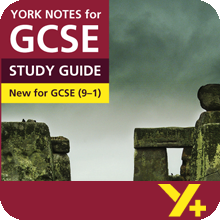Examiner's Notes
You assessed this answer as Grade 3.
Hover over the highlighted text to read the examiner’s comments.
Question: How does Shakespeare present conflict in Macbeth?
Refer to characters and events from the play in your answer.
The play begins with conflict when the witches refer to the battle which is yet to be ‘lost and won’, and as it progresses there are further violent conflicts. In fact, there is hardly a moment in the play when there is peace and calm. Even those moments which seem peaceful, such as the conversation between the Old Man and Ross in Act II Scene 4 talk about conflict, For example, there is the ‘mousing owl which kills the more powerful ‘falcon’. This event echoes the killing of Duncan by someone supposed to be lower in rank.
The main type of conflict is between different characters. The battle at the start is reported by the Captain in Act I Scene 2 and is shown to be very brutal. Macbeth ‘brandished steel/Which smoked with bloody execution’, painting an image of a smoking blade. This conflict is due to the rebellion of the disloyal Thane of Cawdor, who is executed. The fact that the report is delivered by a ‘bleeding Captain’ whose wounds show he is a first-hand witness to the battle adds to the impact. References to ‘blood’ are regularly repeated in the play, reminding the audience of its violent side.
The conflicts that follow are more surprising. Macbeth seems unwilling, at first, to murder his king and is uncertain in Act I Scene 7 whether to do it, telling himself that violent acts can come back to haunt you – they ‘return to plague the inventor’. This could be seen as a different type of conflict – emotional conflict. Macbeth suffers from this for much of the play but seems to give up worrying about it towards the end. Maybe when you have committed so many violent acts you become desensitised. However, the opposite is true of Lady Macbeth – she goes from being quite cold about the murder she has planned to racked with guilt – so her self-conflict leads to uncertainty and shame.
A more hidden conflict is the one between Macbeth and Banquo. In fact, a better word could be rivalry. Banquo suspects Macbeth of his crime and is also ambitious himself. In Act III Scene 1 he wonders about the witches’ prophecies that he should be ‘the root and father of many kings’. Macbeth knows Banquo stands in his way, so it is inevitable he will try to get rid of him, which he does. This murder, and the attempt on Fleance’s life, is one of seven or eight major violent events in the play, including the death of children. This alone conveys a very brutal atmosphere to the play.
The most obvious conflict of all exists between Macduff and Macbeth. It begins when Macduff questions Macbeth as to his actions after the murder of Duncan, and then refuses to attend his coronation. This snub shows Macduff is someone whom Macbeth cannot count on for support. Once Macduff’s family have been brutally murdered, Shakespeare presents the conflict between them as a mission of revenge. Macduff is determined to be the one to kill Macbeth. ‘If thou be’st slain, and with no stroke of mine,/My wife and children’s ghosts will haunt me still.’
It is through conflict that the plot develops, and it is through conflict, or the end of it, that order is restored when the rightful king, Malcolm, is back on the throne. The fact he calls Macbeth a ‘dead butcher’ suggests to the audience that Macbeth was no more than a brutal killer.
